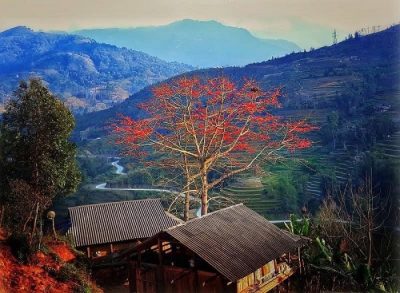Although not the most famous or magnificent tomb in Hue, Gia Long Tomb, also known as Thien Tho Tomb, is still one of the most impressive tombs with special significance, being the burial place of the king who founded the Nguyen Dynasty. Nestled under vast pine forests, with its ancient and wild beauty, Gia Long Tomb in Hue is an attractive destination for visitors to learn about the history of the Nguyen Dynasty, interesting side stories, and enjoy the picturesque scenery.
Introduction to Gia Long Tomb in Hue
Gia Long Tomb is located in Dinh Mon village, Huong Tho commune, about 20 km west of Hue city center. This is a complex of tombs including the tomb of King Gia Long, the tombs of two queens, and other members of the Nguyen royal family. The tomb was built in 1814 and completed in 1820. According to historical records, the Gia Long Tomb complex is situated in a very special feng shui location. The land for the tomb was found by two mandarins, Tong Phuc Luong and Pham Nhu Dang, along with geomancer Le Duy Thanh, who identified it as a place where all good influences from the surrounding mountains and hills converge.
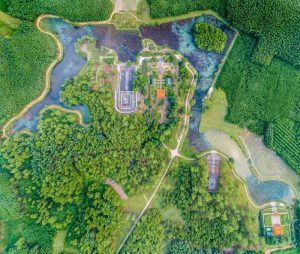
Specifically, there are 42 mountains around the Gia Long Tomb complex, each with its own name. The king personally surveyed and approved the location, participated in planning, directed the design, and supervised the construction.
Over time, the Gia Long Tomb complex has suffered damage and decay in many areas, such as Thoai Thanh Tomb or the resting place of Queen Hieu Khuong, the tomb of Princess Thai Truong, and Thien Tho Tomb. In 2020, the Hue Monuments Conservation Center officially began restoring the architectural works of the Gia Long Tomb complex with many renovation projects. After the restoration, the tomb complex was almost completely restored, enhancing its landscape and architectural value, making it an attractive destination for visitors to Hue.
Exploring the Beauty and Architecture of Gia Long Tomb
The beauty of the Gia Long Tomb complex is created by its location and architecture. Besides the beauty of a mountainous area with 42 surrounding mountains, including Dai Thien Tho Mountain, the largest, serving as the front screen of the king’s tomb. The mountain complex covers an area of over 28 km², creating a majestic scene stretching from the foot of the Truong Son range to the Ta Trach riverbank. Overall, Gia Long Tomb in Hue is divided into three main areas: the tomb area, Minh Thanh Temple, and Bi Binh area.
1. Minh Thanh Temple
Minh Thanh Temple is one of the prominent attractions in the Gia Long Tomb complex. The temple is located on Bach Son Hill and is used to worship King Gia Long and Queen Thua Thien Cao. The architecture of Minh Thanh Temple follows the style of overlapping roofs, with yellow glazed tiles and dragon and carp motifs on the roof edges, a characteristic decoration style of Nguyen Dynasty architecture. In 2016, the temple was restored and re-tiled, but the original paint color was retained. On both sides of Minh Thanh Temple are the East and West houses, also roofed with glazed tiles. These houses were used as resting places for the guards of King Gia Long’s tomb.
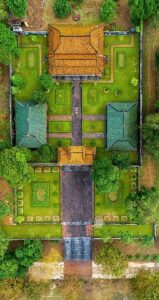
Inside Minh Thanh Temple, the altar of King Gia Long is placed in the center, with the ancestral tablets of Emperor The To Cao and Queen Thua Thien Cao inside. The altar is made of wood with intricate inlays. Previously, Minh Thanh Temple housed many ritual items such as cranes standing on turtles, a set of five ritual objects, and the king’s personal items like tables, brass stands, and brushes. King Minh Mang also placed many memorabilia associated with King Gia Long’s life, such as armor, saddles, and swords. However, over time, these valuable artifacts have not been preserved.
On full moon days or the first days of the month, visitors or the guards of Gia Long Tomb often buy fruits and flowers to offer at the king’s altar in Minh Thanh Temple.
2. The Tomb of King Gia Long and Queen Thua Thien Cao
The tombs of King Gia Long and Queen Thua Thien Cao are located on Thanh Son Hill and Bach Son Hill. In front of the tomb area are six terraced courtyards, each with three steps for easy access. The courtyards are paved with Bat Trang tiles, with rows of stone statues on both sides, including elephants, horses, and mandarins made of sandstone. The remains of King Gia Long and the queen are buried in two adjacent tombs made of Thanh stone. A unique feature is that the tombs of King Gia Long and Queen Thua Thien Cao are of the same size and design, placed 24 cm apart, following the principle of “male left, female right.”
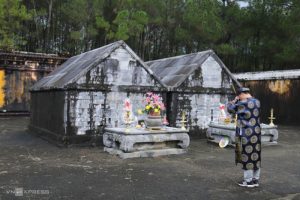
Each tomb has an altar made of Thanh stone with a kneeling leg design. The king and queen’s tombs share a common screen and are surrounded by two walls. The tombs are very simple, without carved patterns or gilding, differing completely from the tombs of other kings. An interesting feature is that when viewed from behind, the peak of Dai Thien Tho Mountain aligns precisely with the junction of the two tomb roofs. This unique feng shui aspect makes Gia Long Tomb one of the most architecturally and feng shui distinctive tombs in Vietnam. Outside the two tombs is a wall system with a bronze gate, leading to the resting place of the king and queen, usually opened only during Tet or memorial days for cleaning and offerings.
3. Bi Dinh
Bi Dinh is a common architectural feature in the tombs of Nguyen Dynasty kings. At Gia Long Tomb in Hue, Bi Dinh is located to the left of the king’s tomb. The design of Bi Dinh follows the ancient tower style with two roofs, situated on Thanh Son Hill. Inside Bi Dinh is a Thanh stone stele with intricate carvings, named “Thanh Duc Than Cong.” This stele was erected by King Minh Mang to praise King Gia Long’s merits. Despite nearly 200 years, the detailed carvings and patterns on the stele remain clear.
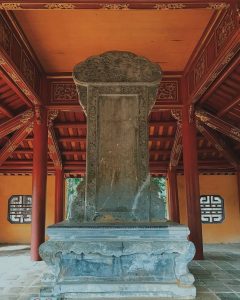
4. Thien Tho Huu Tomb and Gia Thanh Temple
Thien Tho Huu Tomb and Gia Thanh Temple are also important parts of the Gia Long Tomb complex. This is the burial place and temple of Queen Thuan Thien Cao, King Gia Long’s second wife and the mother of King Minh Mang.
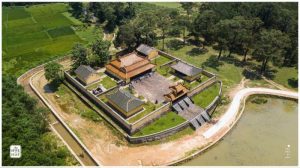
In front of Thien Tho Huu Tomb is a beautiful, poetic lotus pond, creating an impressive scene. To the right of Queen Thuan Thien Cao’s tomb is Gia Thanh Temple, also used to worship the queen, with architecture similar to Minh Thanh Temple. Visitors appreciate the beautiful and harmonious landscape of Gia Thanh Temple compared to the overall architecture and beauty of the Gia Long Tomb complex. Besides these architectural features, Gia Long Tomb also includes other elements such as Hoang Co Tomb, Thoai Thanh Tomb, stone paths, and walls around the pond.
Gia Long Tomb and the Story of Eternal Love
Besides the beauty and unique architecture of Gia Long Tomb in Hue, it is also associated with the beautiful love story of King Gia Long and his first queen. King Gia Long, born in 1762 as Nguyen Phuc Anh, founded the Nguyen Dynasty (1802–1820). During his lifetime, the country was divided, and King Gia Long endured over 25 years of hardship and battles.
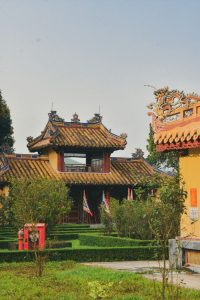
In 1802, after defeating the Tay Son, King Gia Long ascended the throne, officially founding the Nguyen Dynasty, using the national name Vietnam, and ending centuries of civil war. This was a significant historical milestone in the life of the first Nguyen Dynasty king. King Gia Long reigned for 18 years and died of illness in 1820 at the age of 59. Known as a strong and dignified king, few people know that he had a faithful and loving relationship with his first wife, Queen Thua Thien Cao. Queen Thua Thien Cao, born Tong Phuc Thi Lan, was the daughter of Duke Tong Phuc Khuong, known for her beauty and manners. She entered the palace at 18, was later titled Nguyen Phi, and accompanied the king through many ups and downs. In 1802, when the king ascended the throne, she was crowned queen in 1803.
Despite having many concubines, the king only crowned her as queen. In 1814, the queen passed away at 53, and King Gia Long mourned her for a year and decided to build a tomb following the ancient practice of joint burial so that he could be buried next to her after his death. This touching love story of the king and queen adds special significance to Gia Long Tomb compared to other Nguyen Dynasty tombs.
Gia Long Tomb in Hue is considered a wonderful painting, with a perfect blend of nature and architecture, where the natural landscape is a crucial element creating the distinctive beauty of the scenery. Visiting Gia Long Tomb, visitors can immerse themselves in a peaceful yet poetic space, explore the architectural works, and learn about the turbulent life and special love story of King Gia Long. This will be a valuable journey for those who love exploring the history of the Nguyen Dynasty.



